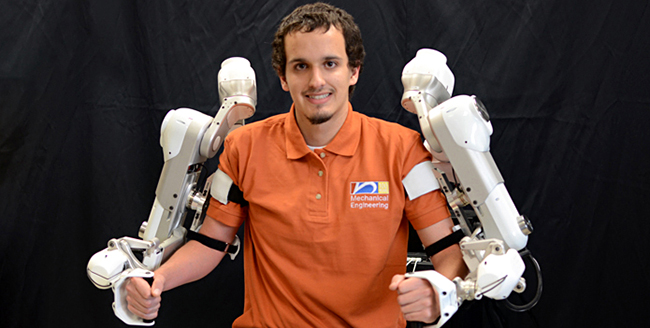Patients in rehabilitation for strokes and spinal cord injuries may one day find a robot rotating their arms under the supervision of a physical therapist.
The product of four years of research in the ReNeu Robotics Lab, HARMONY helps patients regain arm motion by wrapping around a patient’s arms as an exoskeleton and moving with a patient’s arm movements.
The robot can be programmed to guide a patient’s arms or simply provide additional movement support at various degrees depending on the patient’s needs, according to BongSu Kim, lead designer and mechanical engineering doctoral student. The robot can also record data during use, which physical therapists can use to tailor treatment to an individual.
Kim said HARMONY would not be commercially available for at least another five years. Kim said he doesn’t know what the price of HARMONY would be for certain, however, he said the cost of the most similar physical therapy robot on the market, the Switzerland-based Hocoma robot, is $250,000.
Kim said HARMONY differs from Hocoma because it is capable of fully rotating the shoulder.
“HARMONY has five axes on the shoulder, so it supports the full mobility of the human shoulder,” Kim said. “It’s important to support a wide range of motion to realize variety of types of rehabilitation exercise.”
According to Evan Ogden, mechanical engineering graduate student researcher, HARMONY is currently in subject trials. The robot will then have to pass trials for patients with neurological injuries before it can be brought to market.
Ogden said he thinks physical therapy robots have the potential to become more commonplace and complex in the future, but physical therapy robots do not pose the threat of replacing physical therapists themselves.
“Having been through physical therapy myself and having talked with them, I think that there are certain therapy judgments that have to be made in certain aspects of the patient’s performance that I don’t think can be replaced with a robot,” Odgen said. “I think the main things is that I see this as an additional tool to help improve therapy outcome and help people go through more effective rehabilitation.”
University Health Services physical therapist Emily Gonzales said that HARMONY would not supplement her work, as the University’s physical therapy clinic deals with orthopedic injuries rather than neurological ones.
Anthropology and biology senior Krystin Samms, who has gone through physical therapy before, said she does not like the idea of doing physical therapy with a robot.
“I think I would prefer actual people,” Samms said. “It’s more encouraging than a machine.”
This article has been updated since its original publication. There is no set price for HARMONY, although the most similar physical therapy robot is priced at $250,000.





















